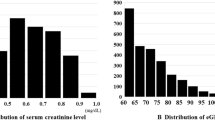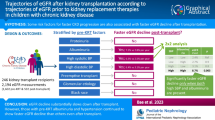Abstract
We sought to describe rates of kidney function decline and to identify modifiable risk factors for CKD progression in a multicenter prospective cohort study of adolescents with CKD aged 11 to 18 years seen semiannually for up to three years. Of the 23 subjects meeting inclusion criteria, the average estimated GFR was 51 ± 27 ml/min/1.73 m2 (0.85 ± 0.45 ml/s/1.73 m2) at entry. The overall annualized decline in GFR was 5.6 ml/min/1.73 m2 (0.093 ml/s/1.73 m2) per year (95% confidence interval [95% CI]: 1.9 to 9.3 [0.032 to 0.16]). The adjusted annualized decline in GFR was found to be accelerated in males, as well as among those over 15 years of age. The adjusted annualized decline in GFR was greater among those with either anemia (hematocrit below 36%), or hypoalbuminemia (albumin below 4 g/dl [40 g/L]). After adjustment, anemia was associated with an accelerated decline of 7.8 ml/min/1.73 m2 (0.13 ml/s/1.73 m2) (95% CI: 3.3 to 12 [0.055 to 0.20]) and hypoalbuminemia was associated with an accelerated decline of 17 ml/min/1.73 m2 (0.28 ml/s/1.73 m2) (95% CI: 11 to 22 [0.18 to 0.37]). Further study is needed to evaluate whether treatment of anemia or hypoalbuminemia, as outlined in current clinical care guidelines for CKD, may slow the progression of CKD in adolescents.




Similar content being viewed by others
References
Wright JT Jr, Bakris G, Greene T, Agodoa LY, Appel LJ, Charleston J, Cheek D, Douglas-Baltimore JG, Gassman J, Glassock R, Herbert L, Jamerson K, Lewis J, Phillips RA, Toto RD, Middleton JP, Rostand SG, African American Study of Kidney Disease and Hypertension Study Group (2002) Effect of blood pressure lowering and antihypertensive drug class on progression of hypertensive kidney disease: results from the AASK trial. JAMA 288:2421–2431
McClellan WM (2005) Epidemiology and risk factors for chronic kidney disease. Med Clin North Am 89:419–445
Hunsicker LG, Adler S, Caggiula A, England BK, Greene T, Kusek JW, Rogers NL, Teschan PE (1997) Predictors of the progression of renal disease in the modification of diet in renal disease study. Kidney Int 51:1908–1919
Lin CY, Sheng CC, Chen CH, Lin CC, Chou P (2000) The prevalence of heavy proteinuria and progression risk factors in children undergoing urinary screening. Pediatr Nephrol 14:953–959
Ardissino G, Testa S, Dacco V, Vigano S, Taioli E, Claris-Appiani A, Procaccio M, Avolio L, Ciofani A, Dello Strologo L, Montini G, Ital Kid Project (2004) Proteinuria as a predictor of disease progression in children with hypodysplastic nephropathy. Data from the ital kid project. Pediatr Nephrol 19:172–177
Litwin M (2004) Risk factors for renal failure in children with non-glomerular nephropathies. Pediatr Nephrol 19:178–186
Mitsnefes M, Ho PL, McEnery PT (2003) Hypertension and progression of chronic renal insufficiency in children: a report of the North American pediatric renal transplant cooperative study (NAPRTCS). J Am Soc Nephrol 14:2618–2622
Wingen AM, Fabian-Bach C, Schaefer F, Mehls O (1997) Randomised multicentre study of a low-protein diet on the progression of chronic renal failure in children. European study group of nutritional treatment of chronic renal failure in childhood. Lancet 349:1117–1123
Schwartz GJ, Haycock GB, Edelmann CM Jr, Spitzer A (1976) A simple estimate of glomerular filtration rate in children derived from body length and plasma creatinine. Pediatrics 58:259–263
Gerson A, Hwang W, Fiorenza J, Barth K, Kaskel F, Weiss L, Zelikovsky N, Fivush B, Furth S (2004) Anemia and health-related quality of life in adolescents with chronic kidney disease. Am J Kidney Dis 44:1017–1023
Gerson AC, Riley A, Fivush BA, Pham N, Fiorenza J, Robertson J, Chandra M, Trachtman H, Weiss R, Furth SL, Council on Pediatric Nephrology and Urology of New York/New Jersey, Kidney and Urology Foundation of America (2005) Assessing health status and health care utilization in adolescents with chronic kidney disease. J Am Soc Nephrol 16:1427–1432
Schwartz GJ, Gauthier B (1985) A simple estimate of glomerular filtration rate in adolescent boys. J Pediatr 106:522–526
Diggle PJ, Heagerty P, Liang KY, Zeger SL (2002) Analysis of Longitudinal Data, 2nd edn. Oxford, New York, New York
Little RJ, Rubin DB (2002) Statistical analysis with missing data. Vol Second. Wiley, Hoboken, NJ
Zandi-Nejad K, Brenner BM (2005) Primary and secondary prevention of chronic kidney disease. J Hypertens 23:1771–1776
Stevens P (2005) Optimizing renal anaemia management-benefits of early referral and treatment. Nephrol Dial Transplant 20(Suppl 8):viii22–26
Remuzzi G, Ruggenenti P, Benigni A (1997) Understanding the nature of renal disease progression. Kidney Int 51:2–15
Burton CJ, Walls J (1966) Interstitial inflammation and scarring: Messages from the proximal tubular cells. Nephrol Dial Transplant 11:1505–1523
Furth SL, Cole SR, Moxey-Mims M, Kaskel F, Mak R, Schwartz G, Wong C, Muñoz A, Warady B (2006) Design and methods of a prospective cohort study of chronic kidney disease in children (CKiD). Clin J Am Soc Nephrol 1:1006–1015
Schwartz GJ, Furth S, Cole SR, Warady B, Munoz A (2006) Glomerular filtration rate via plasma iohexol disappearance: pilot study for chronic kidney disease in children. Kidney Int 69:2070–2077
Acknowledgments
This study was presented in part at the Pediatric Academic Society Meeting, May, 2004, Washington D.C. The Functional Outcomes in Adolescents Study was funded in part by The Kidney and Urology Foundation of America. Dr. Furth is supported in part by UO1-DK-66174 (Chronic Kidney Disease in Children cohort study (CKiD) by the National Institute of Diabetes, Digestive and Kidney Disorders, with additional funding from the National Institute of Neurological Disorders and Stroke, National Institute of Child Health and Human Development, and the National Heart, Lung, and Blood Institute. Dr. Cole was supported in part by the National Institutes of Health through the data coordinating center for CKiD (UO1-DK-066116). The CKID website is located at https://doi.org/www.statepi.jhsph.edu. Dr. Fadrowski was supported by the American Kidney Fund’s Clinical Scientist in Nephrology Fellowship Program.
Author information
Authors and Affiliations
Consortia
Corresponding author
Rights and permissions
About this article
Cite this article
Furth, S.L., Cole, S.R., Fadrowski, J.J. et al. The association of anemia and hypoalbuminemia with accelerated decline in GFR among adolescents with chronic kidney disease. Pediatr Nephrol 22, 265–271 (2007). https://doi.org/10.1007/s00467-006-0313-1
Received:
Accepted:
Published:
Issue Date:
DOI: https://doi.org/10.1007/s00467-006-0313-1




